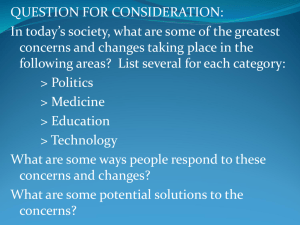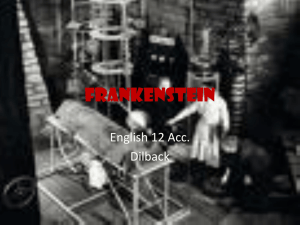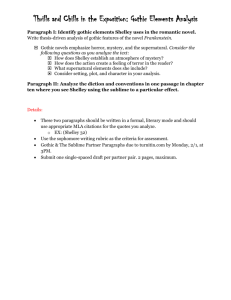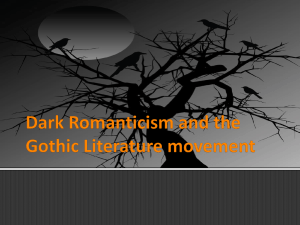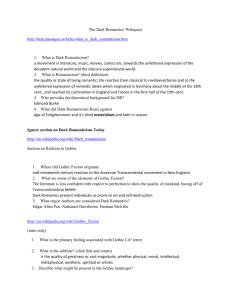The Romantic Period - Crestwood Local Schools
advertisement
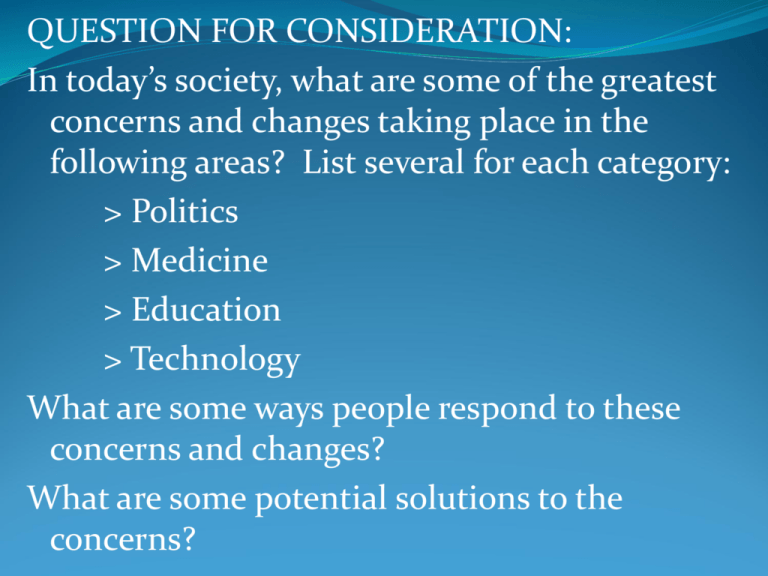
QUESTION FOR CONSIDERATION: In today’s society, what are some of the greatest concerns and changes taking place in the following areas? List several for each category: > Politics > Medicine > Education > Technology What are some ways people respond to these concerns and changes? What are some potential solutions to the concerns? English 11 Indicators: Reading Applications: Literary Text 2 – Analyze the historical, social, and cultural context of setting. Reading Applications: Literary Text 6 – Recognize characteristics of subgenres and explain how choice of genre affects the expression of a theme or topic. Background: The Romantic Age was full of change. It was an age of political revolution (the American Revolution had succeeded along with an ongoing revolution in France). It was also an age of industrial and agricultural revolution, particularly for Britain. In 1807, gas street lights began to appear in London; just over 20 years later, the principles of electromagnetic induction were discovered, which led to the Age of Electricity. Between 1798 and 1832, railroads sprang up in England and continental Europe, photography was invented, and the first U.S. patent was granted for a device known as the typewriter. Romanticism: A Movement of Protest Romanticism was the movement that reflected upon and responded to these dramatic changes. It dominated intellectual and artistic life well into the early 19th century and was considered a movement of protest. Jean Jacques Rousseau (1712-1778) “Father of Romanticism” “Human society is based on a contract between the government and the governed.” His ideas helped inspire the French Revolution. Humans, left in their natural state, are essentially “good and happy.” (“Noble savages”) Evil is not a result of human nature, but of society’s influence. Other Influential Intellectuals: Samuel Taylor Coleridge (Britain)—Rejected the world of science and industry William Wordsworth (Britain)—England’s greatest Nature Poet; friends with Coleridge William Blake (Britain)—Poet who contrasted the innocence of childhood to the destructive effects of the Industrial Revolution Noah Webster (America)—Made it his goal to prove that the new nation’s language was as good as its mother tongue. George Gordon Byron (Britain)—Lord Byron; British poet & leading figure in Romanticism Mary Wollstonecraft (Britain)—Philosopher, feminist, mother of Mary Shelley Lord Byron (1788-1824) IMPORTANT FACTS: Considered one of the greatest British poets and “philosophical rebels” Celebrated for his wealthy indulgences including extreme debt and numerous affairs and scandals Respected by his followers for his radical and extreme rebellion (was once described as “mad, bad, and dangerous to know”) Contemporary of Mary Wollstonecraft Godwin (Shelley), Percy Byssche Shelley Best Known Works: “She Walks in Beauty,” “When We Two Parted,” and Don Juan Mary Wollstonecraft (1759-97) IMPORTANT FACTS: She published Vindication on the Rights of Women (1792), which advocated equality of the sexes, and the main doctrines of the later women's movement. This work made her both famous and infamous in her own time. She ridiculed prevailing notions about women as helpless, charming adornments in the household. Society had bred "gentle domestic brutes." She believed that education held the key to achieving a sense of self-respect and a new self-image that would enable women to put their capacities to good use. Wife of William Godwin, philosopher and writer; mother of Mary Wollstonecraft Godwin Shelley Mary Shelley (1797-1851) IMPORTANT FACTS: Daughter of William Godwin & Mary Wollstonecraft Her mother died shortly after Mary was born; raised by her liberal father Married Percy Bysshe Shelley, philosopher & Romantic poet She & Percy spent a summer with Lord Byron near Geneva, Switzerland, where she was inspired to write Frankenstein Wrote Frankenstein when she was 18 years old Lived a life surrounded by death (see handout) Key Characteristics of Literary Romanticism: Focus on the Imagination – Romanticism turned away from 18th century emphasis on reason and pretense and embrace imagination and genuineness. Many Romantics turned to a past or an inner dream world that they felt was more picturesque and magical than the ugly industrial age in which they lived. Focus on the Individual – Romantic-era poets and writers rejected the public, formal, and witty works of the previous century; they preferred language that spoke of personal experiences and emotions. Romantic writers championed the value of the individual human being. Because of this, Romantic writers turned away from organized authority and strove for individual freedom. Key Characteristics of Literary Romanticism: The “Byronic Hero” – Because of the focus upon the individual’s freedom and the turning from pretensions, the heroes of Romantic literature were often passionate yet flawed individuals: intellectually searching, incapable of compromise, forever brooding over some mysterious past sin, painfully yet defiantly alone. Romantics celebrated “heroes” such as Cain, Faust, Prometheus, and Napoleon. These “rash rebels” were hailed or resurrected in reaction to a world in which order and restraint ruled the day. Key Characteristics of Literary Romanticism: Focus on Nature – Romantics though of nature as transformative; they were fascinated by the ways nature and the human mind “mirrored” each other’s creative qualities. They saw nature as beautiful, but they were more concerned with how nature could evoke strong emotions. Romantic writers had a strong sense of nature’s mysterious forces. The Gothic Novel With the focus on the imagination in Romantic literature grew a stronger and stronger concentration on the supernatural and the mysterious. A whole new genre of literature of this type became known as the “Gothic.” The earliest Gothic tales included The Monk by M.G. Lewis, The Mysteries of Udolpho by Ann Radcliffe, and Frankentstein by Mary Shelley. The intention of the Gothic novel?—To make readers’ blood run cold! Characteristics of Gothic Tales: Eerie Subject Matter: Gothic tales focus on the mysterious the eerie, the fantastic, the supernatural and the macabre (morbid). The Gothic novel was one way in which people of the Romantic Age expressed a sense of helplessness about forces beyond their control: frightening revolutions and industrialization’s unsettling economic changes. Isolated Settings: The Gothic setting is usually remote—haunted castles, eerie forests, graveyards, ruins, and wildly picturesque and often overgrown landscapes. Imperfection is, in a sense, “glorified” and ruin is enhanced. The unpredictable aspects of nature reflect human aspirations and failures. Characteristics of Gothic Tales: Melancholy Atmosphere: Gothic tales use dark atmosphere to create mood. The remote setting creates an often gloomy or pessimistic atmosphere and sense of despair for the reader. (Ex: Mary Shelley uses the icy mists of the Arctic and the bleak windswept Alpine glacial fields to emphasize spiritual and social isolation of the characters.) Rebellious Protagontist (Byronic Heroes): Gothic heroes are usually trapped in gloom and unable to appreciate uplifting circumstances. They are descendants of Cain, Satan, and Prometheus. They are heroic in their rebellion but pathetic in their destiny. DISCUSS: Suppose you were invited to join a scientific project led by a very successful scientist and dedicated to discovering the secret of creation. You could become empowered with the knowledge of how to generate life. You could invent a new kind of being, eliminate aging, and perhaps even conquer death. You might give life to a new species, which would credit you forever as its creator. Would you be willing to dedicate your energy and intellect, forsake your friends, and give up your youth for the sake of such an experiment? What kinds of devastating results would such a discovery have on society? What good could such power bring to humanity?
